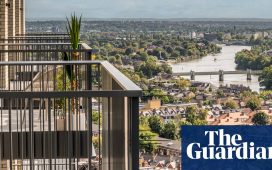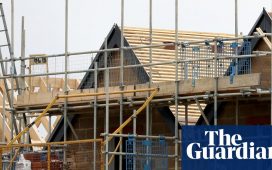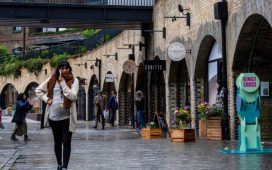Unlock the Editor’s Digest for free
Roula Khalaf, Editor of the FT, selects her favourite stories in this weekly newsletter.
The European Central Bank plans to leave its original headquarters in the centre of Frankfurt next year, bidding farewell to the 40-floor Eurotower skyscraper that became a symbol of the single currency’s launch 25 years ago.
The move, announced on Tuesday, means the ECB will no longer occupy the offices next to the iconic “Euro” sculpture, although its 1,700 banking supervision staff will only be one block away after they transfer to the nearby Gallileo tower at the end of next year.
The central bank, which started moving many of its employees from the Eurotower to a new twin-tower HQ in eastern Frankfurt from 2014, said the latest change was part of a plan to reduce its “physical and environmental footprint” by cutting energy usage and costs.
Staff at the ECB are allowed to work remotely for about half the working week, meaning its offices often feel empty and it needs less space. It will cut the number of buildings it operates in Frankfurt from three to two when it leaves the Japan Centre, another skyscraper in central Frankfurt, in 2028.
One beneficiary of the shift is the English Theatre, the largest English-speaking theatre in continental Europe, which uses a stage in the basement of the Gallileo building and had faced the risk of eviction in a messy brawl with Commerzbank, the site’s former main tenant.
In a last-minute deal struck in January, the City of Frankfurt agreed to sublet the space for the English Theatre from the building’s owner, CapitaLand. The ECB said on Tuesday it had agreed for the theatre to return to the building after it is refurbished next year.

Built in 2003, the 38-floor Gallileo building is a similar size to the Eurotower but is more modern than the ECB’s original HQ, which was completed in 1977 and is increasingly in need of refurbishment.
The Eurotower was designed by architect Richard Heil and was initially occupied by the Bank für Gemeinwirtschaft, a commercial lender, before the European Monetary Institute — a precursor to the ECB — occupied it in 1995.
The 14-metre high Euro sculpture on Willy-Brandt-Platz, which has become a tourist attraction and a focal point for protesters since it was built in 2001, will be unaffected by the ECB’s move.
The steel sculpture, which is illuminated at night, is owned by the Frankfurt Cultural Committee, a non-profit organisation that supports European integration and the city’s role as a financial centre. However, it is seeking a new sponsor to cover annual maintenance costs of €200,000 after a deal collapsed last year with a company behind caiz, a sharia-compliant cryptocurrency.
Manfred Pohl, the committee’s chair, told the Frankfurter Allgemeine Zeitung daily last year that the sculpture might need to be dismantled or auctioned off if a new sponsor was not found.
Additional reporting by Olaf Storbeck










